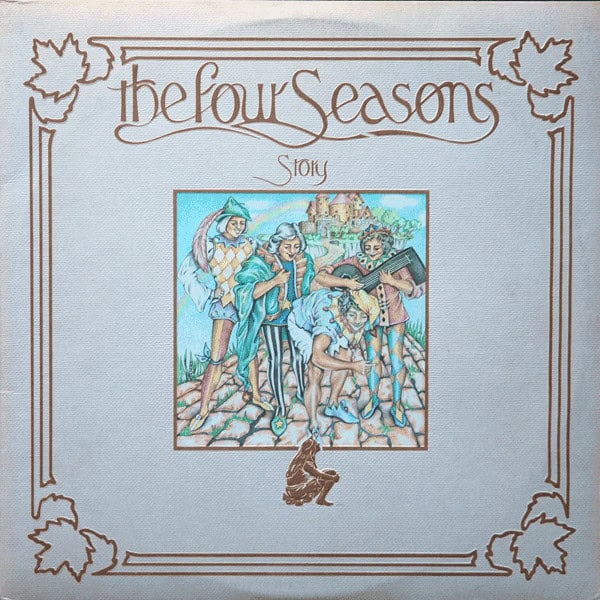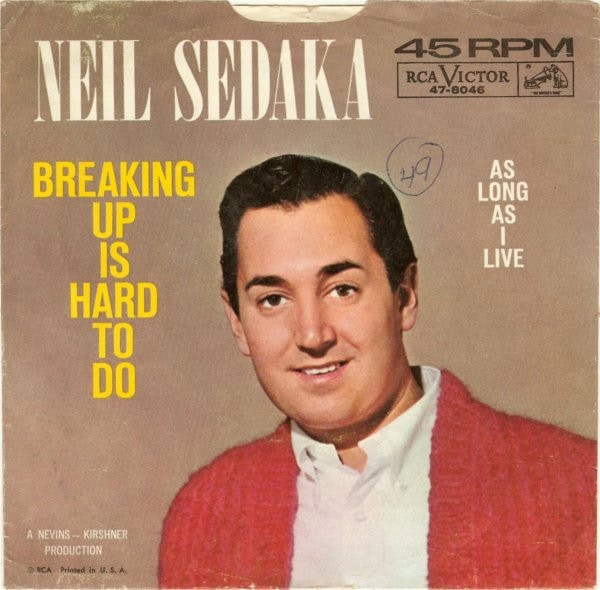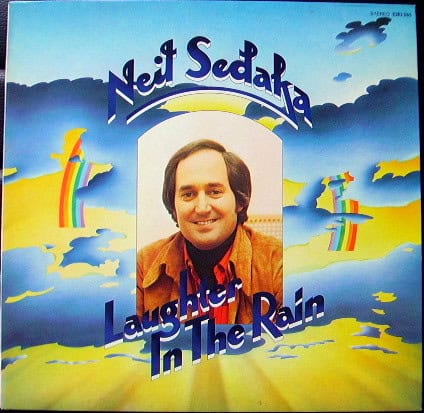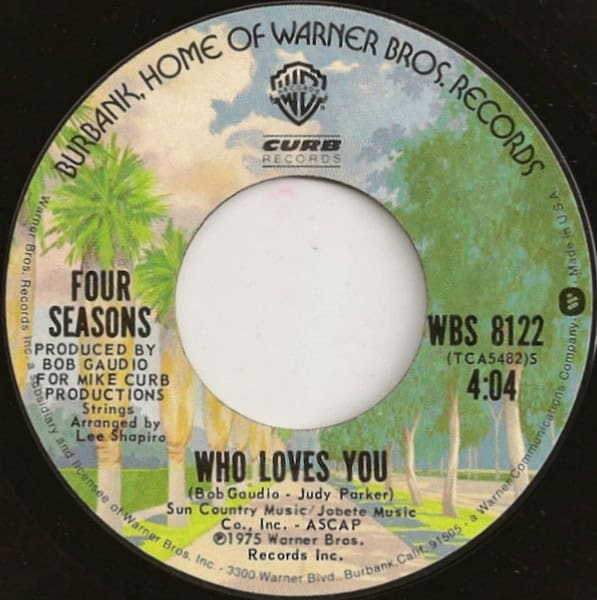The Seasons of Neil Sedaka, Frankie Valli, and The Four Seasons
1962 and 1975, with ups and downs between

The year 1962 brought number 1 hits for Neil Sedaka and for Frankie Valli of The Four Seasons. Their success seemed to diverge, then came back together in 1975. John Crotty digs in the files for perspective on the hits of these prolific musicians.
1975.
The year between Watergate and the Bicentennial. The year that brought us “Jaws,” Microsoft, and the pet rock. Saigon fell. Jimmy Hoffa disappeared. Patty Hearst was captured. UCLA men’s basketball team won another title and the Reds defeated the Red Sox in seven games to claim the World Series.
In the music scene, Elton John continued his long run of hit albums and singles. Other artists who dominated the airwaves included the Eagles, Linda Ronstadt, John Denver, Olivia Newton John, Stevie Wonder, Paul McCartney and Wings, and Earth, Wind and Fire. New artists making their mark included Bruce Springsteen, Barry Manilow, and the Captain and Tennille. And some artists from the early 1960s scored multiple hits in 1975.
At first glance, it seems an unlikely coincidence that Neil Sedaka, Frankie Valli as a solo artist, and The Four Seasons would all have multiple hits in 1975. From the late 1960s through the early 1970s, none of them had been hitting the Top 40 charts. That wasn’t always the case. They all had hits in 1962, including number one hits.
1962.
 The year between the Berlin Wall and the assassination of President Kennedy. The year that brought us the Cuban Missile Crisis, John Glenn orbiting the Earth in Friendship 7, “West Side Story” winning the Oscar for Best Picture, and the convening of the Second Vatican Council. In August of 1962, Neil Sedaka hit number one with “Breaking Up Is Hard to Do,” and in September The Four Seasons hit number one with “Sherry.” In November, The Four Seasons hit number one again with “Big Girls Don’t Cry”; the same week Neil Sedaka reached number 5 with “Next Door To An Angel.”
The year between the Berlin Wall and the assassination of President Kennedy. The year that brought us the Cuban Missile Crisis, John Glenn orbiting the Earth in Friendship 7, “West Side Story” winning the Oscar for Best Picture, and the convening of the Second Vatican Council. In August of 1962, Neil Sedaka hit number one with “Breaking Up Is Hard to Do,” and in September The Four Seasons hit number one with “Sherry.” In November, The Four Seasons hit number one again with “Big Girls Don’t Cry”; the same week Neil Sedaka reached number 5 with “Next Door To An Angel.”
After 1962, the relative success of Neil Sedaka and The Four Seasons diverged. In 1963, Neil Sedaka had a couple of smaller hits and then no further top 40 hits for more than a decade. Conversely, The Four Seasons took off. Between 1963 to 1967, The Four Seasons hit the Top 40 more than 20 times, with 10 of those hitting the Top 10. However, after 1967, like Neil Sedaka, the Top 40 hits stopped coming for The Four Seasons and Frankie Valli until 1975.
Neil Sedaka and Frankie Valli and The Four Seasons all had their roots in the doo wop sound of late 1950s New York. Neil Sedaka’s musical training was in classical music, but when he was in high school he was one of the founding members of the Tokens. Neil recorded some minor hits with them but left the group before its smash hit “The Lion Sleeps Tonight” reached the top of the charts in January 1962 (when Neil also had a Top 10 hit with “Happy Birthday Sweet Sixteen”). Neil’s talent as a songwriter was recognized early on and he signed on with Aldon Music.
 In addition to writing songs for others, Neil began his solo career and had a string of hits between 1959 to 61 before he hit the top of the charts in 1962 with “Breaking Up Is Hard to Do.”
In addition to writing songs for others, Neil began his solo career and had a string of hits between 1959 to 61 before he hit the top of the charts in 1962 with “Breaking Up Is Hard to Do.”
After the British Invasion and other changes in the music scene in the mid-1960s such as surf music, Motown, and folk rock, Neil Sedaka was no longer hitting the charts as a solo artist, but he still had success as a song writer through the 1960s and early 1970s. His music was better received in England and Neil was signed by Elton John’s Rocket Records label. Working with musicians who later formed the band 10cc, Neil Sedaka also began collaborating with a new lyricist, Phil Cody. This combination of new musicians and a new lyricist brought more attention to his 1973 album, “The Tra-La Days Are Over,” and a return to the charts in the 1974 album, “Laughter in the Rain.”
The highs and lows of The Four Seasons are well known thanks to the Broadway hit and subsequent movie version of “Jersey Boys.” Frankie Valli and Tommy DeVito began playing music together in the mid-1950s. Other members of their band changed over the years. In 1959, Bob Gaudio joined with Frankie and Tommy, and the following year Nick Massi rejoined the group. They changed the band name to The Four Seasons and began working with music producer Bob Crewe. Some of their work was doing backup vocals for other artists, but that all changed in 1962. The Four Seasons released their first album in 1962, which included their first hit: “Sherry.” The song quickly rose to the top of the charts and was followed by two more number one hits: “Big Girls Don’t Cry” and “Walk Like a Man.” The Four Seasons found continued success in 1963 to 1967 in spite of the British Invasion and other changes in popular music such as Motown and folk rock.
Dips on the charts, fans on the road
The success of The Four Seasons on the Top 40 charts ended after 1967. Music styles continued to evolve, such as psychedelic, more hard-edged rock, and concept albums.
The Four Seasons tried to keep pace with their 1969 album, “The Genuine Imitation Life Gazette.” The album was a marked departure from the band’s earlier style and was not successful commercially. There were also changes in membership of the band. Nick Massi left in 1965 and was replaced by Joe Long. Tommy DeVito left the band in 1970. Bob Gaudio stopped touring with the band in 1971, but continued working with the band in the studio and writing songs for them. Drummer Gerry Polci joined the band in February 1973, and keyboard player Lee Shapiro joined a month later. Don Ciccone, former guitar player and vocalist with the Critters, was added to the group in early 1974. Guitarist John Paiva, a former member of the Happenings, was a backup musician for the band and replaced Joe Long in 1975.
Although The Four Seasons were not hitting the Top 40 charts in 1968 to 74, they continued to tour successfully. They changed music labels, including an unsuccessful record deal with Motown in the early 1970s. The band released one album, “Chameleon,” in 1972, and recorded songs for a second album, which was never completed. The Four Seasons and Motown parted ways in 1974, with Frankie Valli securing the rights to one of the songs the band had recorded: “My Eyes Adored You.” Frankie signed with a new label and set in motion both his and The Four Seasons’ return to the top of the charts. Frankie Valli recorded “My Eyes Adored You” with other studio musicians and the song would be released for Frankie as a solo artist.
As Four Season’s drummer Gerry Polci recalls, the band still had a sizable fan base and was on the road playing shows all over the country. “We traveled by plane as much as nine months out of the year. We toured all over the country with lots of shows in the Midwest and South.” The shows were in fairly large venues and included a couple of sold-out shows at Madison Square Garden, the Nassau Coliseum, Boston Garden, Hartford Civic Center, and other venues. There was also an extended run of shows in Las Vegas in 1974. Polci recalls playing “about 56 shows in a month-long run in Las Vegas” in 1974, where the band introduced “My Eyes Adored You” to audiences before it was released as a solo single for Frankie Valli.
Changing of tides and contentious times
As the weeks and months of 1974 came and went, there was no sense of inevitability that Neil Sedaka and Frankie Valli and The Four Seasons would soon be scoring multiple major hits, but America was primed and ready. While politics, the economy, and culture in 2024 seem difficult and contentious, they weren’t much better in 1974. In early 1974, America was dealing with an energy crisis after OPEC cut production of oil in response to the 1973 Yom Kippur War. High gas prices and long lines at gas stations were common. The inflation rate jumped from 8% to 12%. And for much of the year, the country was consumed by the Watergate scandal, until President Nixon resigned in August. Given the economic and political blows the country was taking, it was not surprising that some measure of nostalgia was sweeping the country in music, movies, and television.
In 1973, the movie “American Graffiti” turned out to be the big sleeper hit of the year. (The musical “Grease” opened in Chicago in 1971 and on Broadway in 1972). “The Mickey Mouse Club” television show (from 1955 to 59) returned to television in syndication from 1975 to 1977. The television show “Happy Days” debuted in 1974 on the heels of the success of “American Grafitti.” The first year of “Happy Days” was a modest success; in 1975 to 1976 the popularity of the show soared.
Music in the early 1970s still had some connections to music of the late 1950s and early 1960s. Even in 1975, rock and roll was only 20 years old. Some of rock music’s early stars were still hitting the charts. In the third week of October 1972, the top 10 of the Billboard charts had songs by Chuck Berry, Elvis Presley, and Rick(y) Nelson, with Chuck Berry and Elvis holding down the number 1 and 2 spots. Other artists were recording covers of early rock hits. In 1972, Robert John had a number 3 hit with the 1961 to 1962 Tokens’ song “The Lion Sleeps Tonight.” Another number 1 song from 1961, the Marvalettes’ hit “Please Mr. Postman,” was a number 1 hit for the Carpenters in January 1975. And Linda Rondstadt had hits with multiple covers of songs by the Everly Brothers (“When Will I Be Loved”), Buddy Holly (“That’ll Be The Day” and “It’s So Easy”) and Martha and the Vandellas (“Heatwave”). While the music of the early and mid-1970s had evolved from the early rock sounds of the late 1950s and early 1960s, there were still some connections.
The question for Neil Sedaka, Frankie Valli, and The Four Seasons was whether they could update their sound to contemporary tastes. The songs they would release at the end of 1974 and throughout 1975 would answer that question.
 Neil Sedaka started things off by releasing the single “Laughter in the Rain” in October of 1974, from his album “Sedaka’s Back,” which was released in November. The song began a steady climb up the charts, reaching the Billboard Top 10 at the end of December and finally number 1 in February 1975. Shortly after Neil Sedaka released “Laughter in the Rain,” Frankie Valli released the single “My Eyes Adored You” in late November 1974. As “Laughter in the Rain” rose up the charts at the end of 1974 and early 1975, “My Eyes Adored You” followed closely behind. “Laughter in the Rain” hit number 1 in February 1975 and “My Eyes Adored You” hit number 1 in March.
Neil Sedaka started things off by releasing the single “Laughter in the Rain” in October of 1974, from his album “Sedaka’s Back,” which was released in November. The song began a steady climb up the charts, reaching the Billboard Top 10 at the end of December and finally number 1 in February 1975. Shortly after Neil Sedaka released “Laughter in the Rain,” Frankie Valli released the single “My Eyes Adored You” in late November 1974. As “Laughter in the Rain” rose up the charts at the end of 1974 and early 1975, “My Eyes Adored You” followed closely behind. “Laughter in the Rain” hit number 1 in February 1975 and “My Eyes Adored You” hit number 1 in March.
Both Neil Sedaka and Frankie Valli followed up their number one hits with follow-up hits. Neil Sedaka released “The Immigrant” in late March and Frankie Valli released “Swearin’ to God” in May. “The Immigrant” peaked at number 22 in mid-May; “Swearin’ to God” reached number 6 in July 1975. Frankie Valli had a third solo single hit the charts later in 1975. He released a cover of “Our Day Will Come” (the 1962 former number 1 song from Ruby and the Romantics). The song would reach number 11 in December 1975.
 After “The Immigrant” and “Swearin’ to God” finished their run in the Billboard Top 40, Neil Sedaka and The Four Seasons each released their next singles. As Frankie Valli was finding renewed success with solo hits, The Four Seasons were working on their next song, “Who Loves You.” The song was released as a single in August 1975. It would spend 20 weeks in the Billboard Hot 100, 12 weeks in the Top 40 and 7 weeks in the Top 10, peaking at number 3 in November 1975. The success of the song led to the recording of more songs for an album.
After “The Immigrant” and “Swearin’ to God” finished their run in the Billboard Top 40, Neil Sedaka and The Four Seasons each released their next singles. As Frankie Valli was finding renewed success with solo hits, The Four Seasons were working on their next song, “Who Loves You.” The song was released as a single in August 1975. It would spend 20 weeks in the Billboard Hot 100, 12 weeks in the Top 40 and 7 weeks in the Top 10, peaking at number 3 in November 1975. The success of the song led to the recording of more songs for an album.
Meanwhile, Neil Sedaka would release his second number 1 hit of the year, “Bad Blood,” in September. It quickly rose up the charts, hitting number 1 in October 1975. This song is also notable for the uncredited backup vocals by Elton John, on whose Rocket label the song was released. Another interesting feature of the song was Neil Sedaka giving a little tip of the hat to the old doo-wop sound after the second verse of the song (with some doo-ron doo-rons.)
1975 would see not only two number 1 songs sung by Neil Sedaka, but also a monster hit by another group on a song written by Neil. “Love Will Keep Us Together,” sung by The Captain and Tennille, was written by Neil Sedaka and was on his “Sedaka’s Back” album. The Captain and Tennille recorded a cover of it and the song took off, hitting number 1 and staying there four weeks. It was the number one single of 1975. As “Love Will Keep Us Together” was ending its time in the Top 40, another Neil Sedaka-penned song, “Solitaire,” was rising up the charts and would be a Top 20 hit for the Carpenters in the late summer of 1975.
The official Neil Sedaka website
The official Frankie Valli and The Four Seasons website
Adapting sounds
December of 1975 would see Frankie Valli’s version of “Our Day Will Come” peak at number 11, and “Who Loves You” would be finishing its run in the Hot 100. At the same time, The Four Seasons would release their next single, “December 1963 (Oh What a Night)” and Neil Sedaka would likewise release his next single, a remake of his 1962 hit “Breaking Up Is Hard to Do.” This version illustrated how Neil Sedaka changed his style from the 1960s to the 1970s. The 1962 version was an up tempo doo-wop style, whereas the 1975 version was a slower ballad. The remake would reach the Top 10, hitting number 8 in February 1976.
The Four Seasons would follow up their number 3 hit, “Who Loves You,” with “December 1963 (Oh What a Night),” which would reach number 1 in March of 1976 and end up as the number 4 song for the entire year of 1976. This song, along with “Who Loves You,” also illustrated a change in The Four Seasons’ sound compared to the 1960s. Their new hits were not exactly disco songs but were more in a more dance friendly music style. Also, the vocal arrangements were different. While Frankie Valli sang lead on “Who Loves You,” the other members of the group made significant vocal contributions. On the song “December 1963,” Frankie Valli sang only a bridge section of the lyrics, while Gerry Polci and Don Ciccone sang the major portion of the vocals.
The changes in the music style of The Four Seasons in 1975 came, in part, with changes in membership of the band. Drummer Gerry Polci was 21 and keyboard player Lee Shapiro was 20 when each of them joined the band. Gerry had been playing with other bands in New Jersey and Lee was attending the Manhattan School of Music when they joined The Four Seasons. Gerry Polci describes the group’s makeup and musical experience as being “eclectic” but productive. Although the band had not scored a hit in over seven years, “it was still strong musically.” Each of the members contributed to the new songs; while Lee Shapiro was the youngest, he brought significant talent as a music arranger. On “December 1963 (Oh What a Night),” Lee played the synthesizers and managed the horn and string arrangements.
On March 13, 1976, The Four Seasons hit number 1 with “December 1963”; that same week, “Breaking Up Is Hard to Do” finished its run in the Billboard Hot 100. By the time “December 1963” finished its 27-week run in the Hot 100, in May of 1976, Neil Sedaka and Frankie Valli and The Four Seasons had kept one or more of their songs in the Billboard Hot 100 continuously for more than a year and a half. Starting with “Laughter in the Rain” entering the charts in late October 1974 to “December 1963” leaving the charts in mid-May 1976, every week the Hot 100 had a song by Neil Sedaka, Frankie Valli, or The Four Seasons. Most weeks there were songs from two of the artists on the charts at the same time, sometimes in the Top 10. In early November of 1975, The Four Seasons, Frankie Valli (as a solo artist), and Neil Sedaka each had a song in the Top 40. Together, over the span of 15 months, they had 9 Top 40 hits, including four songs that hit the top of the charts.
1976 did not necessarily bring an end to all hits by these prolific artists. Neil Sedaka had another Top 20 hit in 1980, a duet with his daughter, Dara. Their song, “Should’ve Never Let You Go” (another song written by Neil Sedaka with Phil Cody), hit number 19 on the Billboard chart in June of 1980.
Frankie Valli had yet another number 1 solo song in 1978, the title song from the movie “Grease.” It was the number 11 song for the entire year of 1978 and was Frankie Valli’s last solo Top 40 hit.
The Four Seasons returned to the Top 40 charts again in 1993. This was not necessarily a new song; it was a rerelease of a 1988 remix of the song “December 1963 (Oh What a Night).” It was remixed by Dutch music producer Ben Liebrand as a longer dance song. After it was rereleased in 1993, it again climbed the charts, spending 27 weeks in the Billboard Hot 100 and peaking at number 14. Combined with the 27 weeks it spent on the chart in 1975 to 76, the song spent a total of 54 weeks on the Hot 100 chart, the longest any song had remained in the Hot 100 up to that time. It was the biggest-selling single for The Four Seasons.
The success of Neil Sedaka, Frankie Valli, and Four Seasons extends well beyond 1975. In 1983, Neil Sedaka was inducted into the Songwriters Hall of Fame and was awarded the Sammy Cahn Lifetime Achievement Award in 2004. The original members of The Four Seasons (Frankie Valli, Bob Gaudio, Tommy DeVito, and Nick Massi) were inducted into the Rock and Roll Hall of Fame in 1990. The songs of Neil Sedaka, Frankie Valli, and The Four Seasons not only bridged the music of the early 1960s to the mid-1970s, they also spanned the entire year of 1975, and then some.
Neil Sedaka’s pandemic performances
Music in Richmond, Virginia, ‘Back in the Day’
John Crotty is an attorney and hearing officer in upstate New York who enjoys the outdoors, grandkids, and writing.


